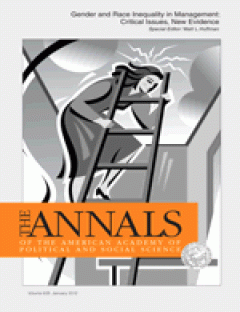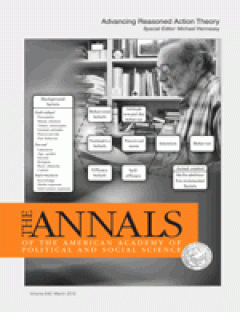Filter by

Organizational de-integration of political parties and interest groups in Den…
Political parties and major economic interest groups often used to be closely linked, but over recent decades they seem to have become more and more detached. Until now, this process has primarily been described in almost deterministic structural models that tell us little about how this detachment takes place and imply that it affects all players at around the same time. The article analyses t…
- Edition
- Vol. 18 no. 1, January 2012,pp. 27-43
- ISBN/ISSN
- 13540688
- Collation
- -
- Series Title
- Party Politics
- Call Number
- -

Party strategies towards civil society in new democracies : The Spanish case
The aim of this article is twofold. First it sheds light on the types of relationship established by political parties with interest groups in new democracies through the identification of the strategies applied by parties towards civil society. Analysis of the Spanish case allows the mapping of three different strategies: the creation and/or sponsoring (of social organizations), penetration (i…
- Edition
- Vol. 18 no. 1, January 2012, pp. 45-60
- ISBN/ISSN
- 13540688
- Collation
- -
- Series Title
- Party Politics
- Call Number
- -

Givers and takers : Parties, state resources and civil society in Portugal
This article assesses the relationship between parties and civil society in Portugal between 1999 and 2009, examining the mediating role of parties in patterns of state funding to civil society organizations. We find evidence of a relationship between parties and organized civil society � albeit an instrumental one, largely based on reward-motivated linkages. The analysis of state grants indica…
- Edition
- Vol. 18 no. 1, January 2012,pp. 61-80
- ISBN/ISSN
- 13540688
- Collation
- -
- Series Title
- Party Politics
- Call Number
- -

Interest group–party interaction in EU politics
Europe has brought about important changes in representation by strengthening the ability of national interest groups to influence policy at the expense of national political parties. Nevertheless, results from a project on the relationship between interest groups and political parties in Denmark, The Netherlands and the United Kingdom show that interest groups still attach high priority to int…
- Edition
- Vol. 18 no. 1, January 2012,pp. 81-98
- ISBN/ISSN
- 13540688
- Collation
- -
- Series Title
- Party Politics
- Call Number
- -

Minority Vulnerability in Privileged Occupations : Why Do African American Fi…
Building on recent work on contemporary forms of bias in meritocratic personnel systems, the author assesses sources of racial disadvantage in an output-based pay-for-performance system for compensating financial advisers in a large financial services firm. Using data from expert reports submitted in racial discrimination litigation, the author shows how racial differences in access to white we…
- Edition
- Vol. 639 no. 1, January 2012,pp 13-32
- ISBN/ISSN
- 00027162
- Collation
- -
- Series Title
- The ANNALS of the American Academy of Political and Social Science
- Call Number
- -

Managing Ambivalent Prejudices : Smart-but-Cold and Warm-but-Dumb Stereotypes
Not all biases are equivalent, and not all biases are uniformly negative. Two fundamental dimensions differentiate stereotyped groups in cultures across the globe: status predicts perceived competence, and cooperation predicts perceived warmth. Crossing the competence and warmth dimensions, two combinations produce ambivalent prejudices: pitied groups (often traditional women or older people) a…
- Edition
- Vol. 639 no. 1,January 2012,pp. 33-48
- ISBN/ISSN
- 00027162
- Collation
- -
- Series Title
- The ANNALS of the American Academy of Political and Social Science
- Call Number
- -

Power, Influence, and Diversity in Organizations
This article summarizes literatures on power, status, and influence in sociology�s group processes tradition and applies them to issues of diversity in organizations. Power�defined as the ability to impose one�s will even against resistance from others�results primarily from position in a social structure. Influence�defined as compelling behavior change without threat of punishment or promise o…
- Edition
- Vol. 639 no. 1, January 2012,pp. 49-70
- ISBN/ISSN
- 00027162
- Collation
- -
- Series Title
- The ANNALS of the American Academy of Political and Social Science
- Call Number
- -

Diversity within Reach : Recruitment versus Hiring in Elite Firms
Despite the popularity of diversity management, there is little consensus on how to design diversity practices that work. In this article, the author provides an inside look into one type of diversity practice: diversity recruitment. Drawing on qualitative evidence from hiring in elite law firms, investment banks, and management consulting firms, the author analyzes what diversity recruitment l…
- Edition
- Vol. 639 no. 1, January 2012,pp. 71-90
- ISBN/ISSN
- 00027162
- Collation
- -
- Series Title
- The ANNALS of the American Academy of Political and Social Science
- Call Number
- -

Developmental Practices, Organizational Culture, and Minority Representation …
Explanations of minority underrepresentation among organizational managers have focused primarily on either employee deficits in human and social capital or employer discrimination. To date, research has paid little attention to the role of developmental practices and related cultural values within organizations. Using data on large U.S. law firms, the authors investigate the role of formal dev…
- Edition
- Vol. 639 no. 1, January 2012,pp. 91-113
- ISBN/ISSN
- 00027162
- Collation
- -
- Series Title
- The ANNALS of the American Academy of Political and Social Science
- Call Number
- -

If You’re So Smart, Why Aren’t You the Boss? Explaining the Persistent Ve…
Since 1970, women have made substantial inroads into management jobs. But most women are in lower- and middle-management jobs; few are in top-management jobs. Human capital theory uses three individual-level variables to explain this vertical gender gap: women acquire fewer of the necessary educational credentials than men, women prefer different kinds of jobs than men, and women accumulate les…
- Edition
- Vol. 639 no. 1, January 2012,pp. 114-130
- ISBN/ISSN
- 00027162
- Collation
- -
- Series Title
- The ANNALS of the American Academy of Political and Social Science
- Call Number
- -

Women’s Mobility into Upper-Tier Occupations : Do Determinants and Timing D…
Data from the 1998 to 2005 waves of the Panel Study of Income Dynamics are used to assess the particularistic mobility thesis, which maintains that among women there is a racialized continuum in the determinants of and timing to mobility into two �upper-tier� occupational categories. Findings support this theory, though racial gaps along the continuum are greater for professional/technical than…
- Edition
- Vol. 639 no. 1, January 2012 ,pp. 131-148
- ISBN/ISSN
- 00027162
- Collation
- -
- Series Title
- The ANNALS of the American Academy of Political and Social Science
- Call Number
- -

Money, Benefits, and Power : A Test of the Glass Ceiling and Glass Escalator …
This article explores the manner in which race, ethnicity, and gender intersect to produce inequality in wages and employer benefits among �workers� (employees with no job authority), �supervisors� (employees with broad supervisory responsibilities), and �managers� (employees who can hire/fire and set the pay of others). Using data uniquely suited to examine these relationships, the author find…
- Edition
- Vol. 639 no. 1, January 2012,pp. 149-172
- ISBN/ISSN
- 00027162
- Collation
- -
- Series Title
- The ANNALS of the American Academy of Political and Social Science
- Call Number
- -

Do Female Top Managers Help Women to Advance? A Panel Study Using EEO-1 Records
The goal of this study is to examine whether women in the highest levels of firms� management ranks help to reduce barriers to women�s advancement in the workplace. Using a panel of more than twenty thousand firms during 1990 to 2003 from the U.S. Equal Employment Opportunity Commission, the authors explore the influence of women in top management on subsequent female representation in lower-le…
- Edition
- Vol. 639 no. 1, January 2012,pp. 173-197
- ISBN/ISSN
- 00027162
- Collation
- -
- Series Title
- The ANNALS of the American Academy of Political and Social Science
- Call Number
- -

Minorities in Management : Effects on Income Inequality, Working Conditions, …
Scholars differ on whether the increase in minority managers represents real or vacuous progress toward the elimination of racial bias in the labor market. This study uses the National Study of the Changing Workforce to examine racial differences in work outcomes across the authority divide. On balance, this study finds more support for the pessimistic view of the minority presence in managemen…
- Edition
- Vol. 639 no. 1, January 2012,pp. 198-216
- ISBN/ISSN
- 00027162
- Collation
- -
- Series Title
- The ANNALS of the American Academy of Political and Social Science
- Call Number
- -

Female Leaders, Organizational Power, and Sex Segregation
A large body of research has examined the organizational factors that promote women�s access to positions of workplace authority. Fewer studies explore how women�s access to these positions influences gender inequality among subordinates. Utilizing a 2005 national sample of South Korean organizations, this article examines whether having women in managerial and supervisory roles is associated w…
- Edition
- Vol. 639 no. 1, January 2012 ,pp. 217-235
- ISBN/ISSN
- 00027162
- Collation
- -
- Series Title
- The ANNALS of the American Academy of Political and Social Science
- Call Number
- -

Checking the Pulse of Diversity among Health Care Professionals : An Analysis…
What factors are associated with variation in the racial/ethnic composition of hospital health care professionals? Institutional theories suggest that organizations react to external environmental and internal structural pressures for the racial/ethnic integration of workers. Using an institutional framework, we bring to bear new insight into how hospitals respond to such pressure for diversity…
- Edition
- Vol. 639 no. 1, January 2012 ,pp. 236-257
- ISBN/ISSN
- 00027162
- Collation
- -
- Series Title
- The ANNALS of the American Academy of Political and Social Science
- Call Number
- -

The Gender Gap in Executive Compensation : The Role of Female Directors and C…
While many studies have explored the issue of women�s representation among top management, little is known about the gender gap in compensation among those who reached the top. Using data on 7,711 executives at 831 U.S. firms, this study investigates social-psychological factors that explain the gender gap in executive compensation. Consistent with theories on social identity and demographic si…
- Edition
- Vol. 639 no. 1, January 2012,pp. 258-278
- ISBN/ISSN
- 00027162
- Collation
- -
- Series Title
- The ANNALS of the American Academy of Political and Social Science
- Call Number
- -

Martin Fishbein’s Legacy : The Reasoned Action Approach
The reasoned action approach that Martin Fishbein pioneered has emerged as the dominant conceptual framework for predicting, explaining, and changing human social behavior. The most popular model in this tradition, the theory of planned behavior, has generated a great deal of empirical research supporting the premises of this approach. It has been shown that behavioral, normative, and control b…
- Edition
- Vol. 640 no. 1, March 2012,pp. 11-27
- ISBN/ISSN
- 00027162
- Collation
- -
- Series Title
- The ANNALS of the American Academy of Political and Social Science
- Call Number
- -

The Quantitative Analysis of Reasoned Action Theory
This article serves as a guide for conducting statistical analyses in a reasoned action context. Using structural equation modeling concepts, the authors identify two elements of reasoned action data: the structural component relating theoretical variables to one another and a measurement component defining the theoretical constructs. The authors then describe a three-step analytic approach: an…
- Edition
- Vol. 640 no. 1, March 2012,pp. 28-41
- ISBN/ISSN
- 00027162
- Collation
- -
- Series Title
- The ANNALS of the American Academy of Political and Social Science
- Call Number
- -

Measurement Models for Reasoned Action Theory
Quantitative researchers distinguish between causal and effect indicators. What are the analytic problems when both types of measures are present in a quantitative reasoned action analysis? To answer this question, the authors use data from a longitudinal study to estimate the association between two constructs central to reasoned action theory: behavioral beliefs and attitudes toward the behav…
- Edition
- Vol. 640 no. 1, March 2012,pp. 42-57
- ISBN/ISSN
- 00027162
- Collation
- -
- Series Title
- The ANNALS of the American Academy of Political and Social Science
- Call Number
- -
 Computer Science, Information & General Works
Computer Science, Information & General Works  Philosophy & Psychology
Philosophy & Psychology  Religion
Religion  Social Sciences
Social Sciences  Language
Language  Pure Science
Pure Science  Applied Sciences
Applied Sciences  Art & Recreation
Art & Recreation  Literature
Literature  History & Geography
History & Geography